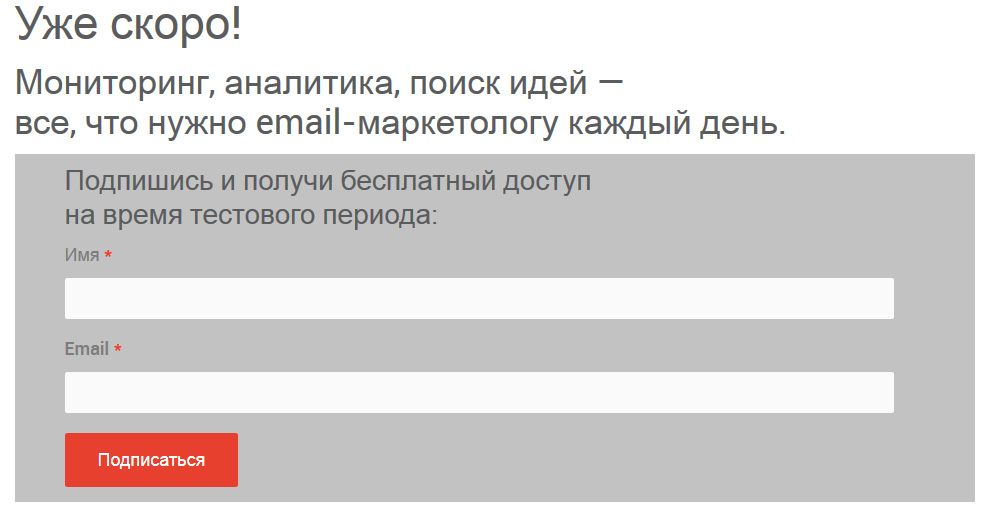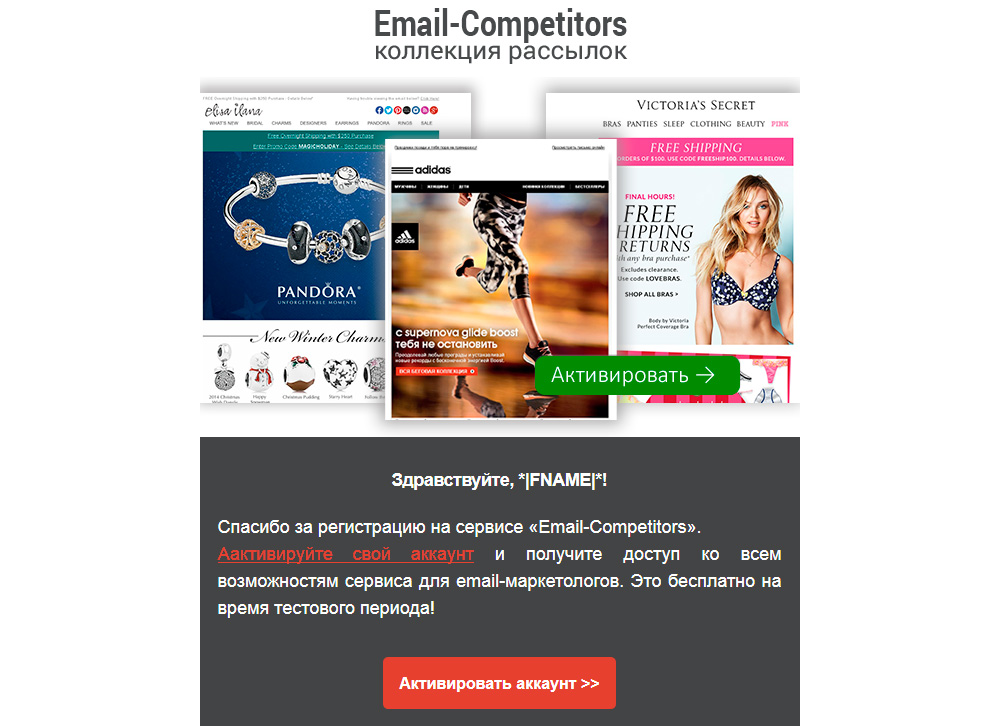Email marketing for a startup, and not only (Part 1)

If you have your own company, then you probably already thought about how to conduct email marketing. And if you haven't thought about it yet, then it's time to start to understand, because today it is already obvious that Email marketing is an effective tool for interacting with customers.
In a series of articles we will share tips on how to use email marketing in a startup at different stages of the project.
The Email-Competitors project was born from the idea of creating a newsletter library that allows you to monitor your competitors, analyze the market and provides a service that helps you solve the challenges of creating effective email newsletters. We have collected and daily replenish a unique database of email marketing practices from thousands of Russian and international companies. You can read more about the Email-Competitors project here ( siliconrus ) and here ( it-eburg ), and in this article we will first of all share our own email marketing experience, but we will try to summarize the recommendations so that they can be used by anyone, making an amendment to specifics of the business.
It happens that the founders of startups are so strongly focused on product development that they don’t think in advance about its launch into the market and about further promotion. Of course, “problems need to be solved as they become available,” but in this case it is not the best approach, because it is much more efficient to prepare well at the time of product launch and gather contacts with your target audience. With email marketing, this can be done at minimal cost.
')
Before project launch - Contact collection
About a month and a half before the launch of Email-Competitors, we created a promotional service page. It looked very simple, briefly acquainted with the capabilities of the service and value proposition for Central Asia. But, most importantly, a contact information collection form was posted on this landing page with a call to subscribe and receive an invitation when the service is launched for beta testing.
The text of the subscription form looked like this:

Important: not to complicate the landing, not to strive to make a large and complex website right away, this is not an easy task and will take a lot of resources. At this stage, this is not the most important thing, it is important to attract Central Asia, briefly and clearly give them an idea of your product and give them the opportunity (the most important thing!) To become your customers.
Technically, Mailchimp was chosen as a platform for email marketing, with which we have already worked and were well aware of its capabilities. At first, a free version is enough for a startup.
The main channel for attracting visitors to our landing page was Facebook. Several posts of the founders on their pages and profile groups about email marketing gave 90 subscribers in the first week. In total, by the time of launch, we scored 160 subscribers who wanted to get an invite to the testing service using free publications on Facebook. From a preliminary assessment of the market, which we, of course, did, we decided that it was enough for a start and you can not waste resources on further attraction. Determine for yourself the necessary and sufficient number of users, based on the specifics of your product and market characteristics.
It is worth mentioning that we launched a project based on Inbox Marketing, and the founders of Email-Competitors are recognized experts in the field of email marketing. If you have not yet become an authority in the chosen field, free attraction channels may not work as well as in our case, and then you need to think in advance about the backup strategy for attracting first subscribers.
We admit honestly: after receiving contacts, we did not interact with our subscribers for a month and a half. Just not enough hands, like all startups. Of course, it is more correct to heat up interest, write to subscribers about the project stage or send already some valuable information. It is enough to write once a week or even once every 2 weeks, more often it is not necessary. If you have such an opportunity, do it.
Launch of the project
Contacts of all the signatories before the launch of the project we brought to the database. It was a database of not activated users. After the start of the project, all subscribers were sent a personal letter, with a personal link to activate the account. However, to our surprise, about half of the users did not activate their accounts, although activation is very easy: it was enough to click on the activation button in the letter, create a password, and start using the service.
We think that a low activation percentage could be due to a delay in receiving a letter, as well as the fact that Gmail letters often fall into other bookmarks, and not into the Inbox. Of course, someone could first subscribe, and then change their mind, someone could get a link on a smartphone - and not everyone is ready to switch to a service directly from a smartphone, enter a password, etc. But there are few reasons why subscribers do not become users. But almost 50% is too agree.
Life after launch
Ten days later, the launch field we already had 400 users (which is quite a good indicator in the b2b segment), but again, about 25% of the accounts are not activated. And here we are seriously thinking about what to do with non-activated users?
We do not know what other projects are doing, we suspect that most often nothing. Larger companies are connecting remarketing, finishing off a person with advertising.
We came up with the following: launch a personalized activator letter (we have marketing with a human face).

Thus, we received an additional 33% of non-activated users without spending money on attracting them.
A trigger was born from this email: automatically send an activation letter to non-activated users. Now this trigger is triggered 1 time, on weekdays, the day after registration. Thus, we have reduced the number of non-activated accounts to 5%.
What you should pay attention to?
Sometimes people specify someone else's email when they sign up. Someone probably thinks that to his acquaintance this may be interesting, someone, perhaps, on the contrary, from harm ... One way or another, one must keep in mind this moment. For example, we received one complaint from the user. What to do? Double opt in, email confirmation. And, of course, activation is not like, not activated. If the user is not activated after receiving the activator letter, he does not get into our mailing list - we never send anything to the user without his consent. This is a matter of professional ethics. If this argument is not enough - just remember your feelings from spam of any kind of brand - and you will understand that our approach is not only more honest, but also more effective.
It is important to monitor the situation daily. One day after the system update, we saw that the previous day, none of the registered users activated the akakunt. Clicks were - activation did not occur. It turns out that after the update there was a bug when activated. We quickly corrected him and immediately sent an apology letter to the signatories. The letter gave us activation, which in another case (if we later discovered a bug or did not let users know that they fixed it) might not be.
In the next post we talk about the triggers that we use and can advise you to use, how to configure them, and what it will give.
Source: https://habr.com/ru/post/290500/
All Articles